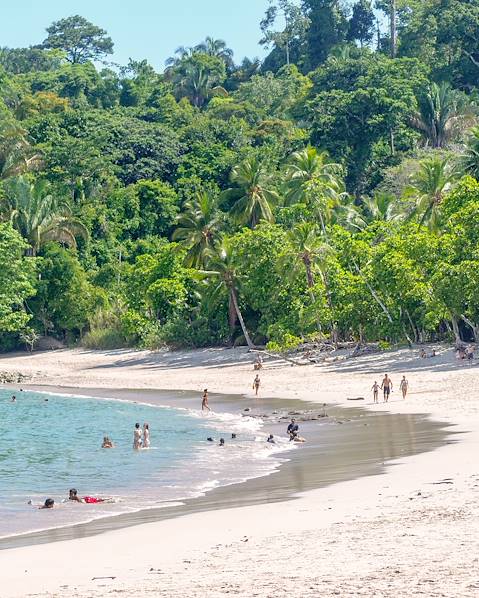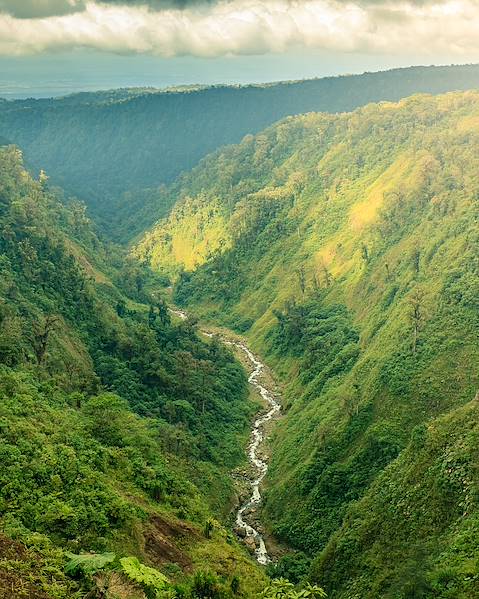A country where wildlife prospers, Costa Rica is the queen of eco-friendly living and the place to immerse yourself in nature. Locals (or ‘Ticos’ as they’re known colloquially) share their home with half a million different creatures, and more than a quarter of the land is designated as protected national parks and nature reserves. But that’s no problem for transport in Costa Rica, which links all corners of the compact country. Adopt their eco-friendly approach and choose to cycle or hike through the emerald cloud forests and volcanic landscapes. Or, embrace the attitude of ‘pura vida’ and hop aboard a local minibus.
By Bus
As the most common way to get around Costa Rica, buses are well-loved by locals and travellers alike. The country’s public bus system is extensive and inexpensive, with virtually all bus services beginning in the capital, San José. While there’s no central bus terminal, offices are scattered around the city where you can purchase advance tickets for popular routes. Timetables can be somewhat unpredictable and subject to change, so be sure to check timings beforehand and confirm the time when buying a ticket. There are two main types of regional bus in Costa Rica: directo and colectivo. The former go from one destination to the next, with few stops in-between, while the latter make a lot more stops along the way and consequently take longer to reach their destination. Local buses also operate between smaller towns and villages, as well as between San José and the suburbs of the city. These tend to be more crowded and less comfortable, although are convenient and reliable for shorter journeys. Shuttle buses are another means of transport in Costa Rica, connecting most of the country’s main tourist destinations. While these tourist-van shuttles are more expensive than public buses, they are often more comfortable, air-conditioned and can even pick you up from your accommodation.
By Car or Taxi
If you’re more of a free spirit and not a fan of transport timetables, then renting a car in Costa Rica is the best way to march (or drive) to the beat of your own drum. You’ll find a number of car rental agencies in San José and other popular tourist destinations. The minimum car rental age is 21 throughout the country and extra care should be taken on roads as they can be rough, rugged, unlit (especially in rural regions) and prone to potholes. It’s advisable to rent a sturdy four-wheel drive vehicle, which many agencies will insist on this during the rainy season (May to November) when river crossings are commonplace. Ensure you familiarise yourself with the local road rules before renting a car and always purchase comprehensive car insurance.
Taxis are another reliable mode of transport in Costa Rica that allow you to travel according to your own timings. In San José, all registered taxis should have metres (marías), however outside of the capital, most do not and fares should be agreed prior to your journey. Taxis can also be rented for longer periods of time, with prices agreed in advance, making them a good option for group trips to further-afield sights.
By Boat
There are some regular coastal boat services in Costa Rica, linking the central Pacific coast to the southern tip of the Nicoya Peninsula, as well as ferry links between the port of Puntarenas and Playa Naranjo. On the Caribbean coast, boat services operate from Cariari to Tortuguero, and Parismina and Siquirres. If you enjoy swapping roads for waterways, it’s also possible to book water taxis between Moín and Tortuguero.
By Plane
For those keen to see as much of Costa Rica as possible, internal flights are the quickest way to travel between San José and popular destinations such as Tortuguero, Quepos and Puerto Jiménez. Avianca is the country’s national airline, which offers domestic services and flights to the US and rest of Central America. Costa Rica has two international airports: Juan Santamaría (SJO) - situated just outside San José - receives the majority of flights, while Daniel Oduber Quiros (LIR) - near the northern city of Liberia - handles the majority of flights from the US, Canada and the UK. Direct flights operate from the UK to both San José and Liberia and take around 11 hours. Our experts can handle all of the details when it comes to organising air travel.
By Bicycle
Cycling is definitely the most sustainable method of transport in Costa Rica, making it fitting for the country’s commitment to all things eco. With an increasing number of paved secondary roads and a burgeoning biking scene, taking to the pathways on two wheels is an excellent way of seeing the epic landscapes in all their glory. Bikes can be rented in most tourist towns and bike tours can also be organised around some regions of the country. It’s important to note that there are no designated cycle lanes in Costa Rica, so cycling is best suited to those who are already road savvy.
















